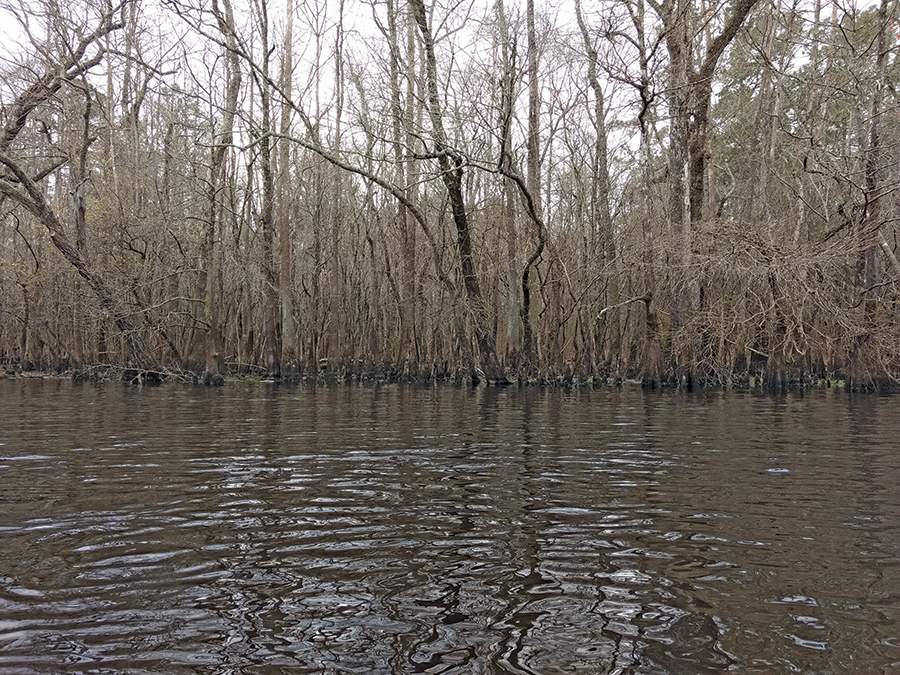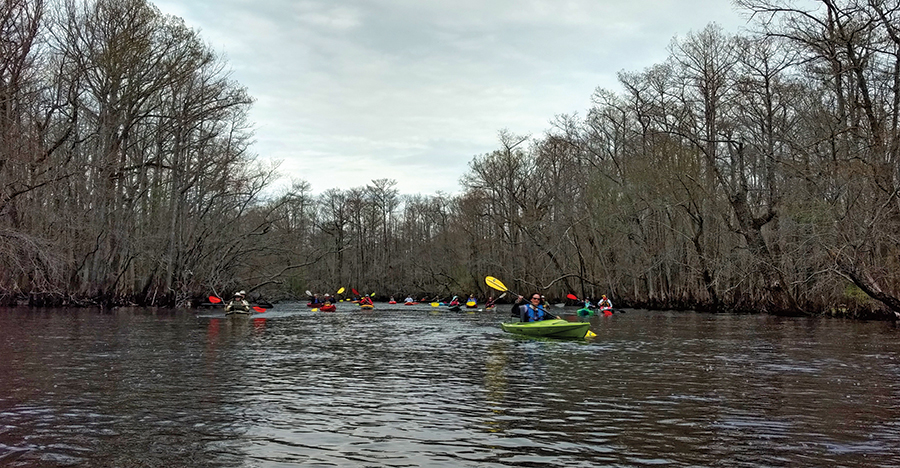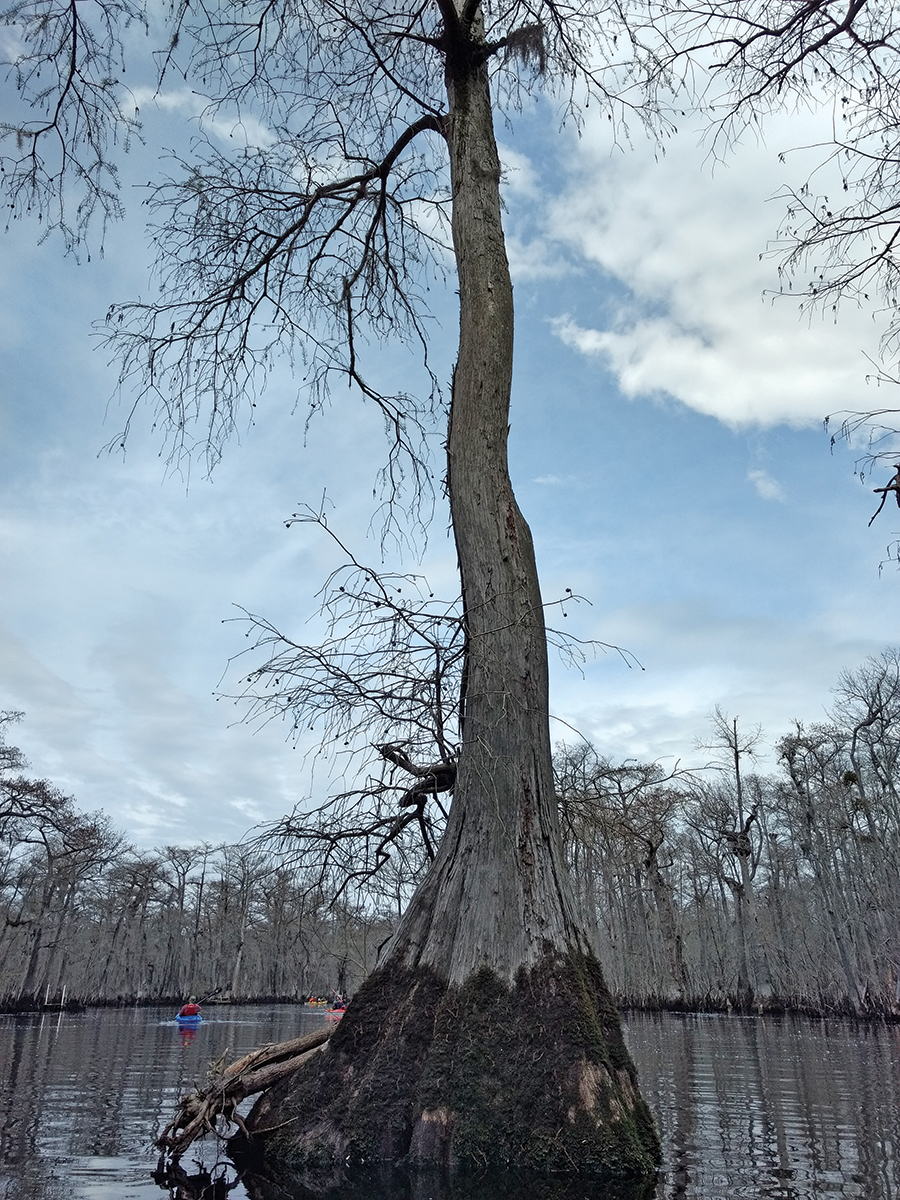Ancient trees and basking in the world of our ancestors
Story and Photographs by John Wolfe
I am bobbing on calm black water beneath a charcoal sky that threatens rain. My kayak is bright orange; there are 29 other boats besides mine in this narrow throat of river, all stroking southeast atop the current, all some unnatural color: deep purples and reds, iridescent greens, blues like the sky will become later in the day, ambers and oranges. A kaleidoscopic flotilla, contrasting with the muted tones of the tangled branches that reach from the banks — visitors from the world of plastic and pavement, here to catch sight of something beyond what we know.
It’s no accident that 30 kayaks have descended on this river today. It is the third Saturday in March, and this is the first in a monthly series of paddle excursions coordinated by Cape Fear River Watch. For 10 years these trips have introduced people to, and familiarized them with, the myriad waterways that crisscross our corner of the state. From now until November, anyone can sign up to rent a boat and join the flock of River Watchers. And I do mean anyone — our group is young and old, made up of both experienced paddlers in sleek, narrow craft and kayaking dilettantes whose main focus is not tipping over — but we are all here for the same reason.
Today we are paddling the Black River. The Black is a tributary of the Cape Fear that empties into that mother river roughly 14 miles upstream from Point Peter in Wilmington. Any artist who has studied the color theory of their paints will tell you black is the ultimate color, the color that contains all others; today, we paddlers are the pigments, this river the work of nature’s brush which draws us all in. And the Black is aptly named, indeed. As an experiment I dip my white-bladed paddle beneath its rippled surface and find it disappears almost immediately into the inky depths. Just below the surface, the paddle turns the color of heavily steeped tea. This is fitting, considering the tannins that stain this water — leached from the accumulated thousands of shed cypress, pine and oak leaves — are of the same type that color the South’s favorite beverage.

The riverbanks are a symphony of gray and green. Cypress trees rise skyward from the sable water, thick and mossy at their bases, tapering to a spindly array of branches from which shoot thin green leaves and the bark-colored orbs that contain their next generations. Their pale knobby knees rise like spirits from the water; silver strands of Spanish moss hang like silent waterfalls. It feels like we have paddled backward through time. Everything is ancient-looking, prehistoric.
This is fitting. Cape Fear riverkeeper Kemp Burdette, who leads the pack in a hunter green canoe, tells me that some of the oldest trees in North America are found in the swampy wetlands of the Black River. Renowned dendrochronologist Dr. David Stahle, in past visits here, took core samples from these cypresses and found a few to be Methuselean in their longevity; a sample from one such tree, nestled deep in the backwaters near a region called the Three Sisters, found it to be 1,760 years old. To give some perspective: The year that tree was a seedling, England, France and Spain had just broken from the Roman Empire. It would be another 1,266 undisturbed years before the first European explorer would even lay eyes on the Cape Fear River (Giovanni da Verrazzano, an Italian who sailed here in service of the king of France in 1524). Yet another cypress — older still, somehow — was found to predate the birth of Christ by nearly 500 years. Stahle hypothesizes that there might be cypresses in the Black River that are upward of 3,000 years old, which would put them among the oldest living trees on the planet.
Life on the Black exists on more conceivable timelines, too. Kemp tells me he has seen owls and wood ducks, red-bellied woodpeckers and herons, beavers, muskrats and otters, to name only a few species. Already today I have heard more bird calls than my novice ear can identify, and glimpsed the ghostly silhouette of an egret spearing fish along the knotted banks. Tucked-away houses with crooked rambling docks reveal the presence of human life, too, as does a rolling peal of man-made thunder: cannon fire from re-enactors at Moore’s Creek, the nearby Revolutionary War battlefield.

One imprint of life which I am thankful that we can’t see (or smell) is the presence of pigs. But that doesn’t mean it’s not here. The headwaters of the Black lie in the undisputed capital of hog country: Sampson and Duplin counties, which contain the highest concentration of concentrated animal feeding operations, or CAFOs, in the world. In Duplin County alone there are approximately 30 hogs to every human, or around 2,450 pigs per square mile. Each animal produces an average of 14 pounds of feces, adding up to about 15,000 tons total, every day — twice as much waste as what the human population of New York City produces. One major difference between the Big Apple and Duplin County (besides the lighter traffic and a complete lack of off-Broadway theater) is how this waste gets treated, or rather, how it doesn’t. The, ahem, excrement is left to fester in open, unlined lagoons, or is piped out to local fields, where it is sprayed in a fine mist as fertilizer. When rain comes, the excess waste runs into drainage ditches, which in turn empty into creeks and streams, which themselves flow into — you guessed it — local rivers, including the Black.
This is a problem for many reasons. In addition to carrying all the bacteria you might associate with untreated sewage (E. coli being chief among them), the runoff also carries high amounts of nutrients like nitrogen. Excessive nitrogen in a waterway can cause harmful blooms of blue-green algae and fish kills from eutrophication (this is when the dissolved oxygen in the water is consumed by microorganisms, leaving very little for larger life forms like fish). What’s bad for the rivers isn’t all that great for the farmers, either. Most of them are subcontractors to the Smithfield corporation, which was recently purchased by the Chinese firm the WH Group. The nature of the contracts these farmers sign is such that the corporation owns the feed, the animal and all the profits; this leaves the farmer with ownership of, and liability for, the land — and, perhaps more importantly, the waste.

“Nice to get out of the city limits every once in a while,” comments the guy paddling beside me, interrupting my mired thoughts. He’s absolutely right. It is nice to escape from the complexities of life in the city, even if only for a morning, and even if not entirely. It’s necessary from time to time to return to the comparative simplicity of nature, to focus on the interplay between boat and paddle and river, between tree and self and sky.
That’s part of the reason we are all paddling here today, getting to know the Black River on a first-name basis. By learning the rivers that trace through the backyards of our cities, we are re-establishing a link between us that has always existed, whether we’ve been aware of it or not. Humans, just like ospreys and fish and cypress trees and otters, need clean waterways; the water in this river will eventually flow into an intake pipe at the public utility and will pour out of my faucet and into my drinking glass. It’s not an exaggeration to say that some of the stuff I’m paddling through now will eventually flow through my very veins. Our health is dependent on the health of our rivers.
Out here, we can bathe in the world as our ancestors did, reconnecting with a reality which, like the cypress tree, is more ancient than ourselves. To paddle here is to reach beyond the nearsightedness of civilization, to recognize how we fit in to a larger puzzle, to understand how our own actions affect our planet. That empires have risen and fallen in the lifetime of a single tree gives us some slight clue to the sublime scale of the world we live in — and to the sweet uncertainty of our own existence. This gift of deep perspective, as well as the gift of water which is life itself, is what rivers like the Black give to us.
John Wolfe studied creative nonfiction at UNCW. When he’s not in the water, he can be found online at www.thewriterjohnwolfe.com.


